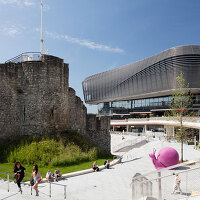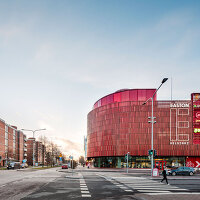
CONTEXT Positioned on the southwestern corner of the Barangaroo South precinct, Barangaroo House marks the southern entry point to one of the largest urban regeneration projects in Sydney for a generation, with development constructed according to a Master-Plan prepared by Rogers, Stirk, Harbour and Partners. The project is the outcome of design excellence competition organised by Lendlease and the Barangaroo Delivery Authority. The brief called for the creation of a new free-standing three story building, to be designed to suit the future needs of a major restaurant and bar venue.

THE DESIGN The overarching design strategy was borne of two crucial responses to site and brief: the urban response of a building ‘in-the-round’, and the holistic integration of planting. The 750m² site of Barangaroo House is unique, with 4 street frontages - 3 pedestrian, and one vehicular. This urban condition influenced the design strategy of rounding the building form - rather than proposing 4 distinct facades or street frontages. On ground level, the curved plan form creates a free-flowing space around the building, encouraging and welcoming movement between the waterfront promenade and adjacent streets.

On the upper levels, the curved form effectively stretches the waterside balconies around the northern and southern faces of the building, increasing the primacy and amenity of these areas which would otherwise be secondary to the large west facing terrace. Frameless glazing opens to the north and west on ground level, offering a seamless connection from the pedestrianised waterfront promenade, to the ground level bar venue, nestled below the 8.5m deep cantilevering balcony above. On the upper levels, operable fine framed glazing effectively transforms entire floor plates into outdoor terraces. The terraces are enveloped by a raised planter box, integrated into the circumference of the curved plan, creating a continuous growing area for both ornamental as well as edible plants which are used in the restaurants food offering.

Internally, a pair of raking columns support a post-tensioned concrete waffle slab, permitting 13m spans, and 8.5m cantilevers. This virtually columnfree floorplan allows for a high level of flexibility in the space planning of the venue, as well as permitting the position of the glazing ribbon to shift on each level. Externally, the building is identified by its sculptural 3-dimensional curving timber facade. The unique facade system uses concentric timber dowels which are individually steam bent into shape, and charred to create a rich dark appearance with low maintenance needs, the finishing technique referring also to the primeval act of burning wood - an essential part of the cooking process.

From early design investigations, we sought to propose a building with a strong visual identity, which spoke of the nature of the program, as well as the uniqueness of the site. Leading hospitality group Solotel are the tenants of the building, with the building subdivided into three distinct venues - House Bar, Bea Restaurant, and Smoke bar. The venue’s offerings are masterminded by Matt Moran, one of Australia’s most celebrated chefs acting as executive chef, with Chef Cory Campbell (ex Noma, Copenhagen and Vue du Monde, Melbourne) responsible for the menus at each level, which each focus on innovative cooking with the incorporation of Australian native produce. The ambition of the project is the creation a welcoming, timeless, convivial structure, that over time becomes a much loved part of the city.

바랑가루 하우스
바랑가루(Barangaroo) 남쪽 구역의 남서쪽 모퉁이에 자리 잡은 바랑가루 하우스는 시드니에서 가장 큰 도시 재생 프로젝트 중 하나로 Southern Rogers, Stirk, Harbor and Partners의 종합계획에 따라 개발되었으며 남부 진입 지점의 시작이다. 이 프로젝트는 Lendlease와 Barangaroo Delivery Authority가 주관하는 디자인 공모를 통해 지어졌다. 공모에서는 주요 프로그램인 레스토랑과 바의 미래 요구 사항에 맞게 새로운 독립된 3층 건물을 요구했다. 가장 중요한 설계 전략은 크게 두 가지로 이루어졌다.‘ 둥근’ 건물과 도시의 조화와 건물 전반적으로 식물을 심는 것을 통합한 디자인을 담은 바랑가루 하우스는 750m²의 규모로 매우 독특하다. 4개의 전면도로와 3개의 보행로 그리고 하나의 차량 전용도로가 있는 대지의 조건 때문에 건물 형태를 둥글게 계획했다.

곡선 형태의 계획은 건물 주변에 자유로운 동선을 만들어, 강변 산책로와 인근 거리 사이의 운동을 유도한다. 수변 쪽의 상층부 곡선형 발코니는 건물의 북쪽과 남쪽면 주변으로 효과적으로 확장하고, 서쪽을 향한 넓은 테라스는 이 지역의 쾌적함과 우수성을 높인다. 프레임 없는 유리는 지상에서 북쪽과 서쪽으로 열려, 보행자가 붐비는 해안 산책로에서 지상 1.5m높이의 캔틸레버 위에 위치한 지상 바까지 연결한다. 상층부의 조작 가능한 미세 프레임 유리는 전체 층을 실외 테라스로 효과적으로 변형시킨다. 테라스는 곡선형 평면의 원주에 통합되어 있는 높은 화분에 둘러싸여, 레스토랑에서 음식 제공에 사용되는 식용 식물을 기를 뿐만 아니라 외부 장식을 위한 연속적인 성장 영역을 만든다. 내부적의 한 쌍의 갈퀴 기둥은 고강도 콘크리트와 슬라브를 지지하고, 13m와 8.5m 길이의 캔틸레버를 만들 수 있게 했다. 실질적으로 기둥이 없는 이 바닥은 공간 계획에 있어 높은 수준의 공간 유연성을 제공할 뿐만 아니라 각 층에서 유리창 리본의 위치를 이동할 수 있게 해준다.

외부적으로는 건물이 3차원 곡선의 목재 입면으로 보인다. 독특한 정면 시스템은 각각 증기로 구부린 동심원 목재 장부촉을 사용하여 검게 그을림으로써, 풍부하고 어두운 외관을 만들어 유지 보수의 필요성이 적게 한다. 이러한 마감 기술은 요리 과정에서 필수적인 나무를 태우는 원시적인 행동과 관련이 있다. 설계를 위해 진행한 초기 조사 단계에서는 프로그램의 특성과 현장의 독특함을 말해 주는 강한 시각적 정체성을 가진 건물을 제안하려고 했다. 이 건물의 세입자는 그룹 솔로텔(Solotel)이며, 하우스 바, 베아(Bea) 레스토랑, 흡연바 등 세 개의 개별적인 장소로 나뉜다. 이 장소에서는 호주의 유명 주방장 중 한 명인 Matt Moran이 Chef Cory Campbell(ex Noma, Copenhagen and Vue du Monde, Melbourne)과 함께 중역 요리사로 활동하고 있으며, 각 레벨의 메뉴는 호주 고유의 농산물과 함께 혁신적인 요리에 중점을 두고 있다. 이 프로젝트의 야망은 시간이 흐르면서 이 도시에서 사랑받고, 환영받는, 시대를 초월한 유쾌한 공간을 만들어 내는 것이다.





Architect Collins and Turner
Location Barangaroo, Sydney, Australia
Structure Arcadis
Mechanical Aurecon
Landscape design Aspect Studio
Interior design H+E Architects, Studio Etic
Client Lend Lease
Photographer Rory Gardiner
해당 프로젝트는 건축문화 2018년 5월호(Vol. 444)에 게재 되었습니다.
The project was published in the April, 2018 issue of the magazine (Vol. 444)
'Architecture Project > Commercial' 카테고리의 다른 글
| Watermark WestQuay (0) | 2018.07.19 |
|---|---|
| Easton Commercial Centre (0) | 2018.07.13 |
| Lane 189 (0) | 2018.07.11 |
| 7 st. Thomas (0) | 2018.07.10 |
| Ports 1961 Shanghai (0) | 2018.07.09 |
마실와이드 | 등록번호 : 서울, 아03630 | 등록일자 : 2015년 03월 11일 | 마실와이드 | 발행ㆍ편집인 : 김명규 | 청소년보호책임자 : 최지희 | 발행소 : 서울시 마포구 월드컵로8길 45-8 1층 | 발행일자 : 매일







